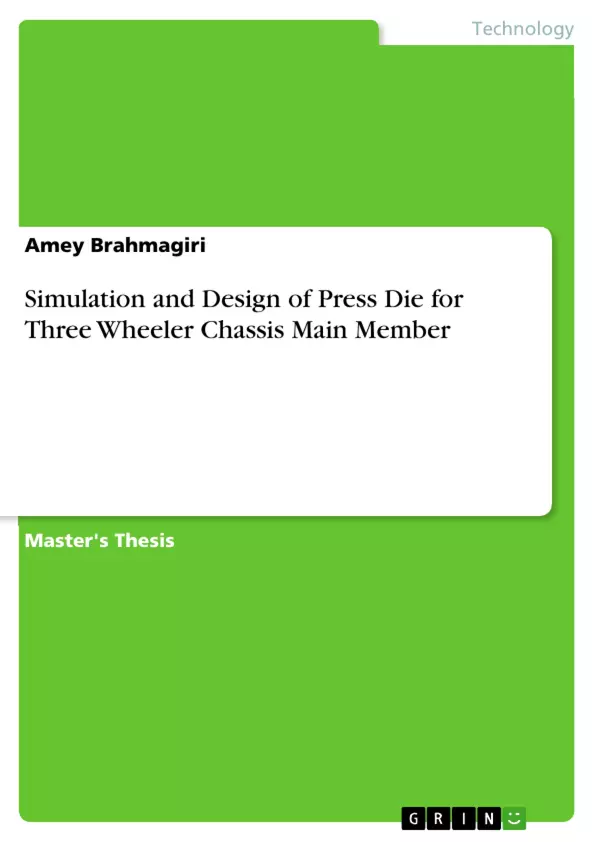
Simulation and Design of Press Die for Three Wheeler Chassis Main Member
Masterarbeit, 2015
53 Seiten, Note: 8.76
Leseprobe
Inhaltsverzeichnis (Table of Contents)
- Abstract
- Acknowledgement
- Symbols and glossary
- Introduction
- Overview
- Objectives of project
- Organization of the report
- Literature review
- Sheet metal forming
- Sheet metal forming process
- Hammering
- Multipoint forming
- Shot peen forming
- Lase forming
- Water jet forming
- Spinning process
- Incremental sheet forming
- Stamping
- Roll forming
- Hydroforming
- Sheet metal properties
- Anisotropy
- Strain hardening
- Strain rate sensitivity
- Young modulus
- Forming limit diagram
- Modes of deformation
- Sheet metal forming
- Die face design and simulation
- Methodology
- Material
- Die faced design
- Inverse simulation
- Forming simulation
- Phases in sheet metal forming
- Implicit and explicit solver
- Setting up simulation
- Results and discussion
- Results of inverse simulation
- Forming approaches
- Develop a SPM
- Use forming and restrike operation
- Use top and bottom blank holder
- Use draw operation
- Roll forming
- Increase the stroke
- Solution adapted
- Validation of results
- Conclusions
- References
Zielsetzung und Themenschwerpunkte (Objectives and Key Themes)
This dissertation focuses on the simulation, design, optimization, and manufacturing assistance for a 3-wheeler chassis main member. The primary goal is to overcome the challenges associated with complex geometries and stringent dimensional tolerances in the production of automotive sheet metal parts, particularly the chassis main member.
- Press die design and simulation for 3-wheeler chassis main member
- Overcoming challenges in sheet metal forming, such as springback, twisting, and dimensional accuracy
- Optimization of forming process parameters
- Integration of software tools for simulation and design
- Application of advanced forming techniques and analysis
Zusammenfassung der Kapitel (Chapter Summaries)
- Chapter 1: Introduction Provides an overview of the project, outlining its objectives and the organization of the report. It highlights the importance of sheet metal forming in the automotive industry and the challenges associated with achieving high-quality and dimensionally accurate components.
- Chapter 2: Literature Review This chapter delves into existing research on sheet metal forming processes, focusing on various methods and their limitations. It discusses key properties of sheet metal materials that influence the forming process, including anisotropy, strain hardening, and strain rate sensitivity.
- Chapter 3: Die Face Design and Simulation This chapter outlines the methodology used in die face design and the materials employed. It explores the concept of inverse simulation and its role in optimizing die geometry. The chapter then delves into the fundamentals of forming simulation, including phases of sheet metal forming, implicit and explicit solvers, and setting up simulation parameters.
- Chapter 4: Results and Discussion This chapter presents the results of the inverse simulation, focusing on the optimized die geometry. It explores various forming approaches, including different forming operations and strategies, and evaluates their effectiveness in achieving the desired part geometry and quality.
Schlüsselwörter (Keywords)
The key terms and concepts covered in this dissertation encompass sheet metal forming, press die design, simulation, optimization, automotive chassis main member, springback, twisting, dimensional accuracy, forming limits, material properties, and software tools such as PAM-STAMP 2G, UG-NX, and Auto CAD.
Details
- Titel
- Simulation and Design of Press Die for Three Wheeler Chassis Main Member
- Veranstaltung
- Master of Technolog - Mechanical CAD/CAM
- Note
- 8.76
- Autor
- Amey Brahmagiri (Autor:in)
- Erscheinungsjahr
- 2015
- Seiten
- 53
- Katalognummer
- V346502
- ISBN (eBook)
- 9783668442467
- ISBN (Buch)
- 9783668442474
- Dateigröße
- 2666 KB
- Sprache
- Englisch
- Schlagworte
- Sheet metal forming Press die Spring back Simulation Tool design
- Produktsicherheit
- GRIN Publishing GmbH
- Preis (Ebook)
- US$ 20,99
- Preis (Book)
- US$ 29,99
- Arbeit zitieren
- Amey Brahmagiri (Autor:in), 2015, Simulation and Design of Press Die for Three Wheeler Chassis Main Member, München, Page::Imprint:: GRINVerlagOHG, https://www.diplomarbeiten24.de/document/346502
- Autor werden
- Ihre Optionen
- Vertriebskanäle
- Premium Services
- Autorenprofil
- Textarten und Formate
- Services für Verlage, Hochschulen, Unternehmen

- © GRIN Publishing GmbH.
- Alle Inhalte urheberrechtlich geschützt. Kopieren und verbreiten untersagt.
- info@grin.com
- AGB
- Open Publishing
Der GRIN Verlag hat sich seit 1998 auf die Veröffentlichung akademischer eBooks und Bücher spezialisiert. Der GRIN Verlag steht damit als erstes Unternehmen für User Generated Quality Content. Die Verlagsseiten GRIN.com, Hausarbeiten.de und Diplomarbeiten24 bieten für Hochschullehrer, Absolventen und Studenten die ideale Plattform, wissenschaftliche Texte wie Hausarbeiten, Referate, Bachelorarbeiten, Masterarbeiten, Diplomarbeiten, Dissertationen und wissenschaftliche Aufsätze einem breiten Publikum zu präsentieren.
Kostenfreie Veröffentlichung: Hausarbeit, Bachelorarbeit, Diplomarbeit, Dissertation, Masterarbeit, Interpretation oder Referat jetzt veröffentlichen!
- GRIN Verlag GmbH
-
- Nymphenburger Str. 86
- 80636
- Munich, Deutschland
- +49 89-550559-0
- +49 89-550559-10
- info@grin.com
-









